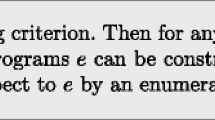Conclusions
Very general models of learning were introduced and compared. Each of the models reflected certain situations that occur in common observations of human learning. For example, teams of learners can learn more than any individual. It was shown that sometimes to learn one concept, another must be mastered first. Sometimes, it is necessary to learn several functions simultaneously in order to learn any of them. An advantage in asking questions about the phenomenon under investigation, as opposed to waiting for data to arrive, is that it enhances learning potential. The more powerful the questions that can be formulated, the more that can be learned. Finally, it was shown that there is an advantage in some forms of procrastination in learning.
Similar content being viewed by others
Explore related subjects
Discover the latest articles, news and stories from top researchers in related subjects.References
D. Angluin, W.I. Gasarch and C.H. Smith, Training sequences, Theor. Comp. Sci. 66(1989)255–272.
D. Angluin and C.H. Smith, Inductive inference: Theory and methods, Comp. Surveys 15(1983)237–269.
D. Angluin and C.H. Smith, Inductive inference, in:Encyclopedia of Artificial Intelligence, ed. S. Shapiro (Wiley, 1987).
L. Blum and M. Blum, Toward a mathematical theory of inductive inference, Inf. Contr. 28(1975)125–155.
R.A. Brooks and A.M. Flynn, Fast, cheap and out of control: A robot invasion of the solar system, J. British Interplanet. Soc. 42(1989)478–485.
A.W. Burks,Collected Papers of Charles Sanders Peirce (Harvard University Press, Cambridge, MA, 1958).
R. Carnap,The Continuum of Inductive Methods (The University of Chicago Press, Chicago, IL, 1952).
R. Carnap and R. Jeffrey,Studies in Inductive Logic and Probability (University of California Press, Berekely, CA, 1971).
J. Case and C. Smith, Comparison of identification criteria for machine inductive inference, Theor. Comp. Sci. 25(1983)193–220.
C. Chatterjee, Cranial anatomy and relationships of a new Triassic bird from Texas, Philos. Trans. Roy. Soc. London (Biology) 332(1991)277–342.
A. Church, The constructive second number class, Bull. AMS 44(1938)224–232.
R. Freivalds and C. Smith, On the power of procrastination for machine learning, Inf. Comp. 107(1993)237–271.
M. Fulk, Prudence and other conditions on formal language learning, Inf. Comp. 85(1990)1–11.
M. Fulk and J. Case,Proc. 3rd Ann. Workshop on Computational Learning Theory (Morgan Kaufmann, Palo Alto, CA, 1990).
W. Gasarch, E. Kinber, M. Pleszkoch, C. Smith and T. Zeugmann, Learning via queries with teams and anomalies, Fundamenta Inf. 23(1995)67–89.
W. Gasarch, M. Pleszkoch and R. Solovay, Learning via queries in [+, <], J. Symb. Logic 57(1992)53–81.
W. Gasarch and C. Smith, Learning via queries, J. ACM 39(1992)649–674.
E.M. Gold, Language identification in the limit, Inf. Contr. 10(1967)447–474.
D. Haussler and L. Pitt,Proc. 1988 Workshop on Computational Learning Theory (Morgan Kaufmann, Palo Alto, CA, 1988).
J.R. Horner and J. Gorman,Digging Dinosaurs (Workman, New York, 1988).
J. Laird, P. Rosenbloom and A. Newell, Chunking in Soar: The anatomy of a general learning mechanism, Machine Learning 1(1986)11–46.
D. Osherson, M. Stob and S. Weinstein,Systems that Learn (MIT Press, Cambridge, MA, 1986).
D.N. Osherson, M. Stob and S. Weinstein, Aggregating inductive expertise, Inf. Contr. 70(1986)69–95.
L. Pitt, Probabilistic inductive inference, J. ACM 36(1989)383–433.
L. Pitt and C. Smith, Probability and plurality for aggregations of learning machines, Inf. Comp. 77(1988)77–92.
K. Popper,The Logic of Scientific Discover, 2nd Ed. (Harper Torch Books, New York, 1968).
H. Putnam, Probability and confirmation, in:Mathematics, Matter and Method, 1 (Cambridge University Press, 1975). Originally appeared in 1963 as a Voice of America Lecture.
N. Rescher,Scientific Explanation (The Free Press, New York, 1970).
R. Rivest, D. Haussler and M. Warmuth,Proc. 2nd Ann. Workshop on Computational Learning Theory (Morgan Kaufmann, Palo Alto, CA, 1989).
H. Rogers, Jr.,Theory of Recursive Functions and Effective Computability (McGraw-Hill, New York, 1967).
P. Schilpp,Library of Living Philosophers: The Philosophy of Rudolph Carnap (Open Court Publ., LaSalle, IL, 1963).
C.H. Smith, The power of pluralism for automatic program synthesis, J. ACM 29(1982)1144–1165.
M. Warmuth and L. Valiant,Proc. 1991 Workshop on Computational Learning Theory (Morgan Kaufman, Palo Alto, CA, 1991).
R. Wiehagen, Limes-erkennung rekursiver funktionen durch spezielle Strategien, Elektr. Inf. verarbeit. Kybern. 12(1976)93–99.
Author information
Authors and Affiliations
Additional information
Supported by NSF grants CCR 8701104 and CCR 8803641.
Rights and permissions
About this article
Cite this article
Smith, C.H., Gasarch, W.I. Recursion theoretic models of learning: Some results and intuitions. Ann Math Artif Intell 15, 151–166 (1995). https://doi.org/10.1007/BF01534453
Issue Date:
DOI: https://doi.org/10.1007/BF01534453




